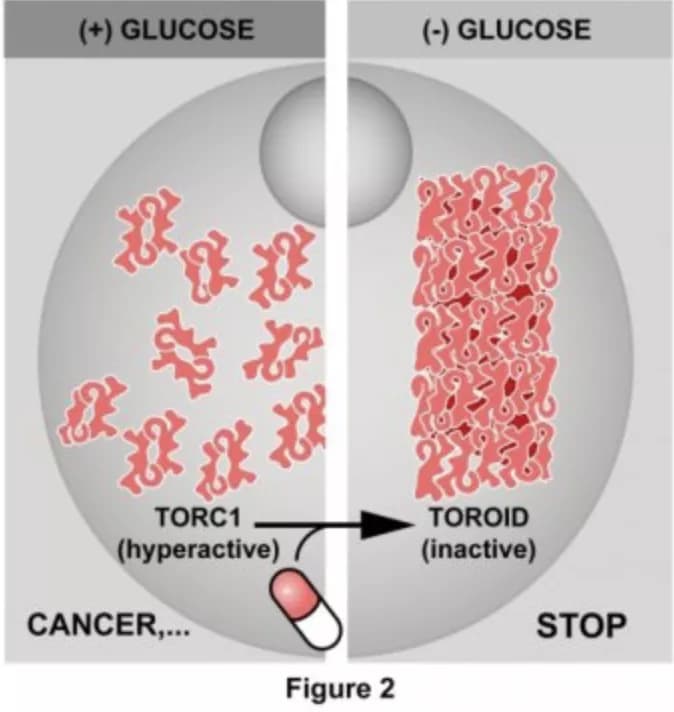
A Tubular Structure To Stop Cell Growth
TORC1 is an enzyme complex that controls the normal growth of our cells; but, when too active, it can promote diseases such as cancer. A study led by biologists from the University of Geneva (UNIGE), Switzerland, and published in the journal Nature describes how sugar regulates the activity of TORC1, through a surprising mechanism. In the presence of this nutrient, individual TORC1s stimulate the various metabolic processes that allow cells to grow. In the absence of sugar, TORC1s assemble into a tubular structure, rendering them inactive and thus cell growth stops. The formation and disassembly of these tubules are easy to observe in living cells, which, in future work, would make it possible to identify compounds that interfere with this process. As regulators of cellular growth, such compounds would represent an interesting anti-cancer strategy.
Some of the treasures of Easter Island are invisible. In the 1960s, researchers discovered a bacterium that produces a compound with potent anti-fungal properties. They called it rapamycin, from the island's native name Rapa Nui. Although evolutionarily distant, fungi and mammals share much of the basic biochemistry that drives cellular growth. Indeed, rapamycin was then found to inhibit growth of human cells too, particularly cancer cells.
The Target Of Rapamycin (TOR), first discovered in yeast, then in humans, is an enzyme that regulates growth. Professor Robbie Loewith, director of the Department of Molecular Biology of the UNIGE Faculty of Sciences, discovered that TOR is present in two distinct protein complexes, TORC1 and TORC2, to regulate different growth-related processes.
Enzyme active sites become inaccessible
TORC1 is hyperactive in several diseases, including cancer, which is a major public health problem. "Cancer cells massively upregulate growth pathways, and are thus particularly sensitive to the presence of sugar. We therefore wanted to understand how this nutrient regulates the activity of TORC1," explains the researcher. Thanks to a collaboration with researchers from UNIGE, the University of Auckland, New Zealand, and the École Polytechnique Fédérale de Lausanne (EPFL), the appearance of a new TORC1 structure in cells was revealed: "When cells are deprived of glucose, individual TORC1s assemble together to form a tubular structure that can reach one fifth of the size of the cell. Formation of this tubule, which we call a TOROID, allows both the storage and inactivation of TORC1 which halts cell growth," explains Manoël Prouteau, a member of the Geneva group and first author of the article.
A molecular construction filmed live
This study, conducted under the umbrella of the National Centre of Competence in Research (NCCR) 'Chemical Biology', also showed that the re-addition of glucose causes the rapid disassembly of TOROIDs, allowing cells to resume their growth with the subsequent reactivation of liberated TORC1s. "This work has been done in yeast; indeed, many of the discoveries related to TOR have been made in yeast before being confirmed in mammals. It is therefore very likely that TOROIDs exist and function in the same way in humans," notes Robbie Loewith.
The assembly and disassembly of TOROIDs, the largest protein helix discovered to date, can be easily observed thanks to the spectacular advances in microscopy methods. This will make it possible to search for compounds that can stabilize or destabilize them, inside cells. Such compounds would be of great clinical interest as modifiers of cell growth.
This discovery could thus pave the way for a new therapeutic approach to treat the numerous diseases associated with the deregulation of TOR's activity. Indeed, although rapamycin already exists as a natural inhibitor of TOR, it has significant side effects, and alternatives are needed.
Materials provided by Université de Genève. Note: Content may be edited for style and length.
Disclaimer: DoveMed is not responsible for the accuracy of the adapted version of news releases posted to DoveMed by contributing universities and institutions.
References:
Manoël Prouteau, Ambroise Desfosses, Christian Sieben, Clélia Bourgoint, Nour Lydia Mozaffari, Davide Demurtas, Alok K. Mitra, Paul Guichard, Suliana Manley, Robbie Loewith. (2017). TORC1 organized in inhibited domains (TOROIDs) regulate TORC1 activity. Nature. DOI: 10.1038/nature24021
Related Articles
Test Your Knowledge
Asked by users
Related Centers
Related Specialties
Related Physicians
Related Procedures
Related Resources
Join DoveHubs
and connect with fellow professionals

0 Comments
Please log in to post a comment.